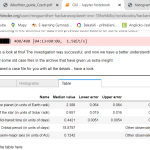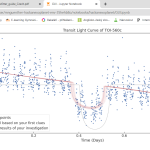
Project Gallery 2023
Secondary students from across Europe became exoplanet detectives with ESA and used Cheops satellite data to uncover the mysteries of two exoplanet targets: KELT-3b and TOI-560c.
Explore the projects below.
GYBOŇÁCI
Gymnázium Boženy Němcové Hradec Králové – Královéhradecký Czech Republic 14 years old, 15 years old 2 / 0
https://exoplanet-toi-560c.webnode.cz/
Youtube Video Link:
https://www.youtube.com/watch?v=HpblR8EWYD8
TOI-560c
TOI-560c project description:
In the first step, we analyzed the information from the Allesfitter program. We got histograms of the statistical probability of all parameter values of the specified exoplanet, as well as its transit light curve. In the next step, we were to determine the volume of the planets. Third, we calculated the distance of the exoplanet from its star. We started from the given data and calculated it using Kepler’s third law. Next, we had to assess whether it is possible for this exoplanet to have life. In the last step, we determined the density of the exoplanet and its composition.
TOI-560c Results and Analysis
The volume of the exoplanet was 1479×1022 m3. We were given the orbit of an exoplanet around its star. It lasts 1,631,206.08 seconds. Using Kepler’s third law, we calculated that the exoplanet’s distance from its star is 0.12494 Au, or 1.869 089 459×1010 m. We had temperature data available. It is 225 +/- 15oC. The question was whether it could be lived on. Our answer is: “no.” We found that it is a solid planet and has a density of 2185 kg/m3. From this we concluded that the main component of the surface on this planet is most likely quartz.
TOI-560c Conclusions
We have calculated the basic data about the exoplanet TOI-560c. But that’s just a shell. For example, the temperature may not be the same everywhere on the surface. The Europeans indicate that the type of this exoplanet is Mini Neptune. But the Americans claim that it is supposed to be a type of Super Earth. Here the question arises, whether there can be life here after all. How thick is that planet’s atmosphere. Isn’t the atmosphere suitable for life? What is the approximate percentage of greenhouse gases? We are probably not able to answer these questions yet.
In order for research and knowledge to deepen, a more perfect mathematical program must be built that, based on images directly from space, can calculate exactly what we will ask of it. Images from space would be taken by a probe that would be an artificial satellite of our Earth. There should be a very powerful telescope on it that will show everything accurately. However, this probe would have to be controllable. Or an easier option, and that is the Webb telescope.
In addition to images, the focus should be on the spectral distribution. Many things can be read from it, such as the composition of the atmosphere. But above all, these researches should be carried out regularly, otherwise nothing more will be discovered.
Supporting files:




